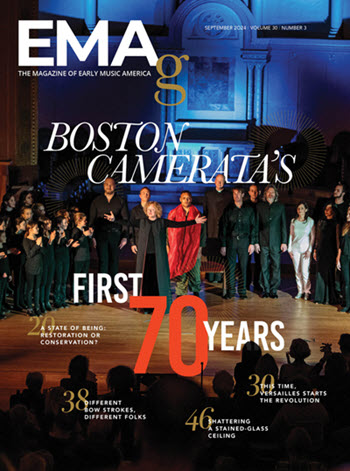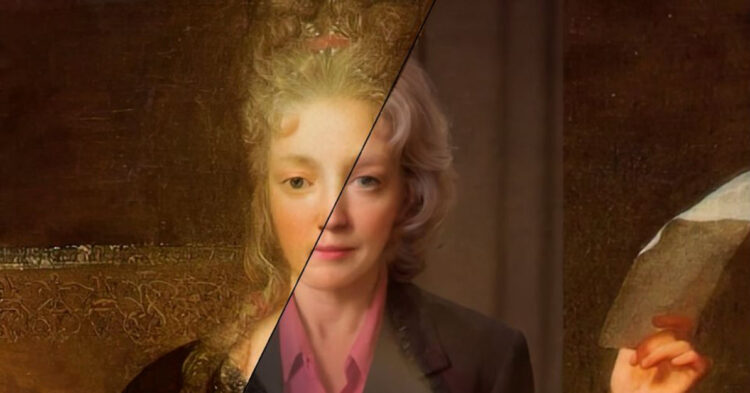From the Publications Director: Beginnings Old and New
This column was first published in the September 2024 issue of EMAg, the Magazine of Early Music America

We love big anniversaries. An ensemble’s milestone is as much a chance to honor its personalities and body of work as it is a time for consideration of its survival strategies. The celebration inherently acknowledges artistic quality, savvy programming and promotion, effective fundraising, and the importance of both stability and serendipity.
This season, the Boston Camerata reaches its 70th anniversary, a well-deserved EMAg cover story. As key players in the development of the U.S. early-music field, much of their history is our history. The tale begins modestly (in a museum basement) with uneven music-making but untapped resources (a historical collection; a city open to the new sounds of very old music). The narrative gains momentum as the ensemble starts to attract top talent (performers, scholars, instrument makers) and really takes off with a generous mindset that defines what’s worthy of study and performance (from historical American styles to global “early music”). This inquisitive attitude has had a lasting effect on the entire field, and maps out an essential direction for our future.
Yet while the big birthdays garner attention, perhaps the birth of a new organization should captivate our interest just as keenly. An ambitious new group ought to offer a fresh combination of ideas and activities, and seek out successful trends from outside our often insular early-music scene — trends in generating excitement, in uncommon repertoire, as well as on compensating players, raising money, attracting and retaining audiences, navigating social media, and a lot besides.
On Sept. 27, an all-star ensemble with a name borrowed from the Cleveland airport code, CLE Concierto, makes its debut with music by Élisabeth Jacquet de la Guerre and her musical circle. It will be fascinating to see how this new band with a unique moniker cuts a distinctive profile in a city overflowing with acclaimed HP ensembles and collegiate groups.

Also later this month, in Vermont, the Burlington Baroque Festival presents its inaugural season: five concerts in four days, featuring some 60 performers from as close as New England and Quebec and as far as South America and Europe. The event is designed to draw attention to what will hopefully become a year-round series of concerts under the title Burlington Baroque, with a core of regional musicians (from the U.S. and Canada) and with international guests in the mix. The project is directed by conductor and keyboardist Eric Milnes.
Unlike Cleveland, Burlington has no resident period-instrument ensemble. That void has been filled in recent years by L’Harmonie des saisons, an award-winning group based in and around Montreal and led by Milnes and gambist and recorder player Mélisande Corriveau. Recent seasons have attracted more than 250 people to each of seven shows. Notably, Burlington is the nearest U.S. town to Montreal, just 90-minutes away.
“We’re always looking for opportunities,” Milnes says, “and for a town its size, Burlington has an extraordinary cultural life — there’s clearly an opening for a lot more early music.”
With a budget of $80,000, Milnes calls the new festival’s funding a “three-legged stool.” There are local donors, led by Burlington Baroque’s board president, Cathy Stadecker; support the Canadians get from home; and, a more delicate situation, travel grants awarded to L’Harmonie des Saisons by the Conseil des arts et des lettres du Québec and the Canada Council for the Arts, which has allowed the ensemble to tour in Burlington, even paying the hefty visa fees. This helps lower the festival’s reliance, somewhat, on ticket sales and U.S. giving.
Understandably, the festival has programmed a popular line-up for its debut, headlined by Monteverdi, Handel, Vivaldi, plus Bach’s Magnificat and Brandenburgs…and, although it might be poo-pooed in some quarters, historically informed Beatles.
Over the years, Milnes arranged a number of Lennon and McCartney tunes for period instruments — no vocals — billed as Beatles Baroque. Milnes and Montreal musicians recorded and performed them widely; they were a hit on the European summer festival circuit. Many of the songs he picked sprang from the late ’60s neo-Baroque vibe (e.g. “Penny Lane” and “All You Need is Love”) and were not, as he says, “drum dependent.” But a few years ago, as Paul McCartney was turning 80, a presenter asked Milnes for a new set. He agreed, but this time with vocals and drums along with harpsichord, viola da gamba, Baroque bassoon, and all the rest.
“When it came time to figure out programming for the festival, I thought, well, we’ve got an open 2 p.m. Saturday slot. All the personnel will already be there.”
Milnes finds “that a lot of Baroque enthusiasts had a real fondness for that rep in our familiar style. Early-music singers have a particular talent for declamation, so I tell them to sing this like McCartney and treat it as a historical document. It’s normal to study our sources.”
For board president Stadecker, “the festival is almost like waving a big banner saying ‘Hey folks, we’re here!’” she says. “We’d like to spread it out over the whole year and get [Burlington] really invested. The festival is testing an idea and testing the market. It’s our chance to calibrate and re-calibrate our plans so Burlington Baroque is a huge success.”
Pierre Ruhe is publications director of Early Music America.

